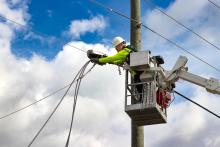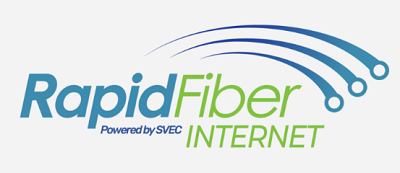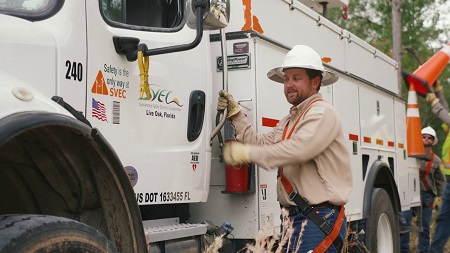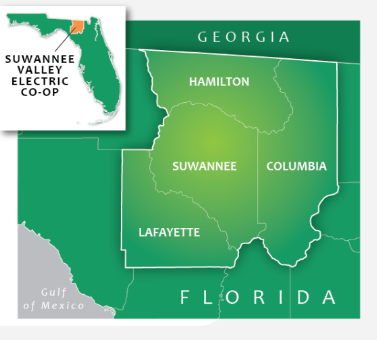
Fast, affordable Internet access for all.

Suwannee Valley Electric Cooperative (SVEC) has begun construction on an ambitious new fiber deployment that will soon bring affordable, multi-gigabit fiber access to all of the cooperative’s existing electrical customers in rural Northern Florida.
Cooperative officials tell ILSR its three-phase build out is well underway, with a beta anticipated this summer and the first commercial customers connected by August. SVEC Communications Director Jon Little says the cooperative’s goal remains to deliver affordable fiber to all 20,000 of the cooperative's current electric customers by the end of 2026.
“We’ve broken our territory into three phases based partly on population or possible customers,” Little said.
The cooperative’s recently created subsidiary, Rapid Fiber Internet, will interface directly with subscribers, while Conexon manages deployment of more than 4,100 miles of fiber. Electrical users won’t see price hikes; the projected $93 million deployment cost will be funded by a combination of grants and loans paid back exclusively through user subscriptions.

Little told ISLR that make ready (preparing utility poles for fiber attachments) prep and engineering for phase one are complete, and make ready construction for phase one is roughly 40 percent complete. He added that primary fiber construction for phase one is roughly twenty percent complete.
“We’re hoping that we will have a group of beta customers starting next month,” Little said. “We want to go about a month to get their feedback, and so we’re still hoping sometime in August to offer hookups to our members on that first feeder.”
Little noted that the cooperative’s deployment cadence will be dictated in part by local adoption in the cooperative’s initial deployment phase.
“We’re planning for about thirty to thirty-five percent take rate, and once we get to around eighty percent of that goal we plan to roll out the next feeder,” he said.
As with similar deployments by other electrical cooperatives and utilities, the upgrades will also assist SVEC with the operations and maintenance of the company’s existing electrical grid and 28,000 meters, of particular importance as climate change ramps up severe weather threats in the hurricane-battered sunshine state.
An End To Decades Of Monopolization And Muted Competition
The finished network should be transformative for a region where local monopoly providers, Windstream and Comcast, have faced decades of criticism for expensive, spotty, and sluggish service. It will be the first time in history most of the cooperative’s target customers have access to affordable, multi-gigabit broadband.
A Rapid Fire Internet FAQ states that connected users will have access to a symmetrical 100 megabit-per-second (Mbps) for $50 a month, a symmetrical gigabit per second (Gbps) tier for $80 per month, and a symmetrical 2 Gbps option for $100 a month. The cooperative also notes all tiers will not feature usage caps or overage fees.
Florida currently ranks 16th in Internet access nationwide, though most of SVEC’s service counties rank among the least connected counties in the state. After decades of frustration by locals, Little says cooperative leaders realized they felt an obligation to act for the betterment of the local populace.
“We’re very involved in our communities,” Little said. “We're local. We're highly active in the communities, and with the leaders of the counties and cities. So we just came to the conclusion after several meetings with county people and some of the other current providers that if we didn't do this, nobody else would.”
The parallels between modern efforts to ensure equitable broadband access and the century-old effort by these same cooperatives to electrify rural America are hard to ignore.

“It’s really kind of in our DNA and history,” Little said. “We were formed back in the thirties because the investor-owned utilities wouldn't serve rural communities. Profitability just wasn’t there. And we see it as the same kind of situation now.”
As with so many cooperatives, utilities, and municipalities freshly expanding access to affordable fiber, SVEC officials say they were greatly motivated by the lack of reliable, affordable broadband access during the Covid lockdown home education and telecommunications boom.
“It really came home during the pandemic when our kids couldn’t attend school via the web very well,” Little said. “The school districts were sending homework out to students using school buses because our kids just didn’t have access to online education.”
As made abundantly evident in states like North Dakota, the end result of cooperatives’ entry into the market isn’t just improvement–it’s an utterly revolutionary upgrade from the kind of expensive and unreliable satellite, DSL, or cable options underserved rural Americans have grown all too accustomed to.
Made Possible by An Historic Round Of Federal Broadband Grants
SVEC General Counsel Crystal Ecker told ILSR the cooperative has been awarded $15 million in federal and state grants within the last year to help fund the $93 million dollar project.
Last February, the Florida Department of Economic Opportunity (DEO) awarded two grants totaling $10 million to SVEC as part of Florida’s Broadband Opportunity Program (BOP), itself made possible by federal Coronavirus relief legislation. In April, BOP awarded SVEC another $5 million to deploy 821 miles of fiber to 21,492 unserved locations in the city of Live Oak, Florida.
According to Ecker, SVEC has also applied for additional funding through the USDA’s ReConnect program and Florida’s Broadband Infrastructure Program (BIP), and is expecting to learn more details about the former application in a matter of weeks.

“We'll likely only be able to accept one or the other, unless one of them allows us to substantially reduce the project area by whatever was funded by the other grant,” Ecker said of its ReConnext and BIP applications.
Grant applicants can’t apply for projects that are already in the works or will be in the works during the grant application and consideration period, Ecker noted. SVEC has applied for grant funding for nearly all of its planned deployment areas excluding those covered by phase one, because that’s expected to be completed before the end of the year, she said.
The fate of the cooperative’s ReConnect and BIP grant applications will determine whether SVEC will apply for a portion of the $1.1 billion in federal funding Florida will receive courtesy of the federal Infrastructure Investment and Jobs Act (IIJA) and the Broadband Equity, Access, and Deployment (BEAD) Program it created.
“It would be a little bit difficult for us to try and create an application for BEAD unless our Reconnect or our BIP grants are not awarded,” Ecker said.
As a result of the cooperative’s efforts, many residents in rural Northern Florida are only a few years away from the kind of affordable fiber access even more populous metropolitan areas still struggle to find. The direct result of a grass roots project driven by locals, for locals, caused by decades of apathy by the region’s entrenched telecom monopolies.
*This story was updated from a previous version to clarify that the cooperative's deployment efforts pertained to phase one of the construction
Header image of Suwannee Valley Electric Cooperative worker hanging fiber couresty of Suwannee Valley Electric Cooperative
Inline images courtesy of Suwannee Valley Electric Cooperative
